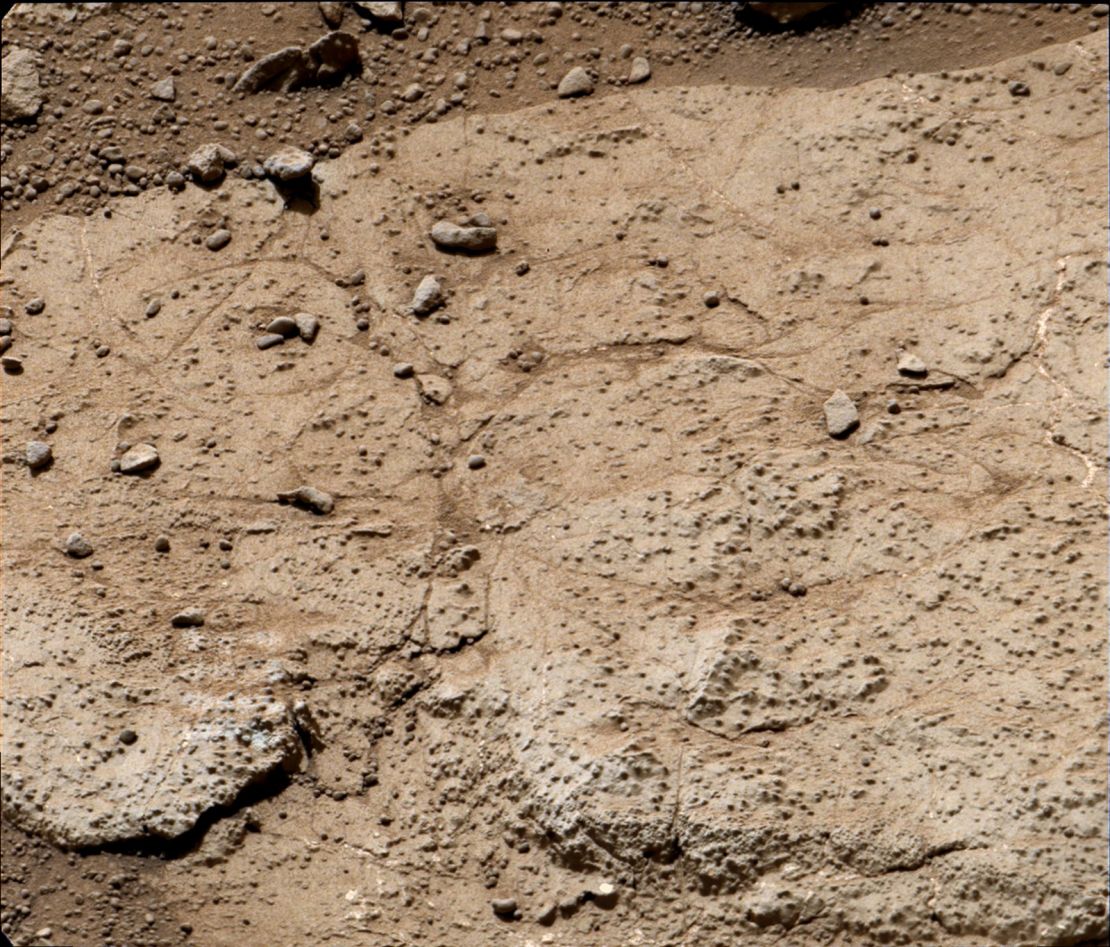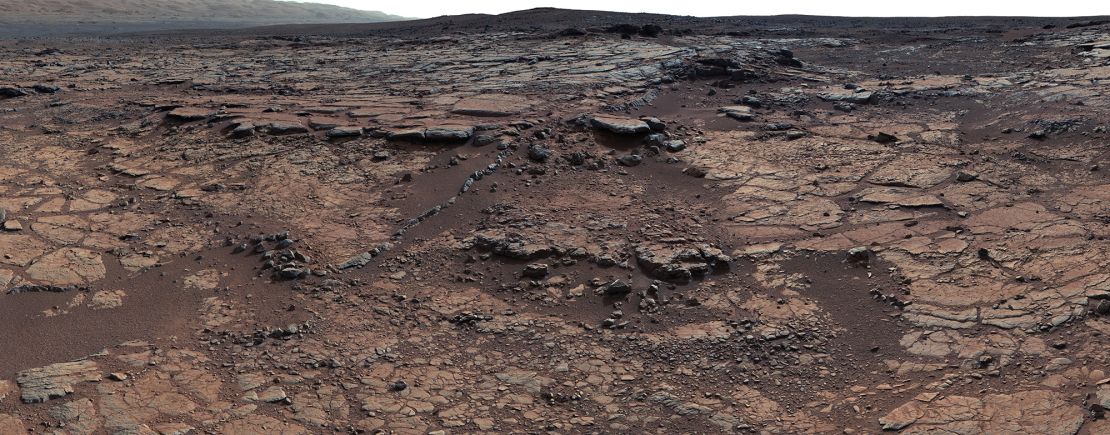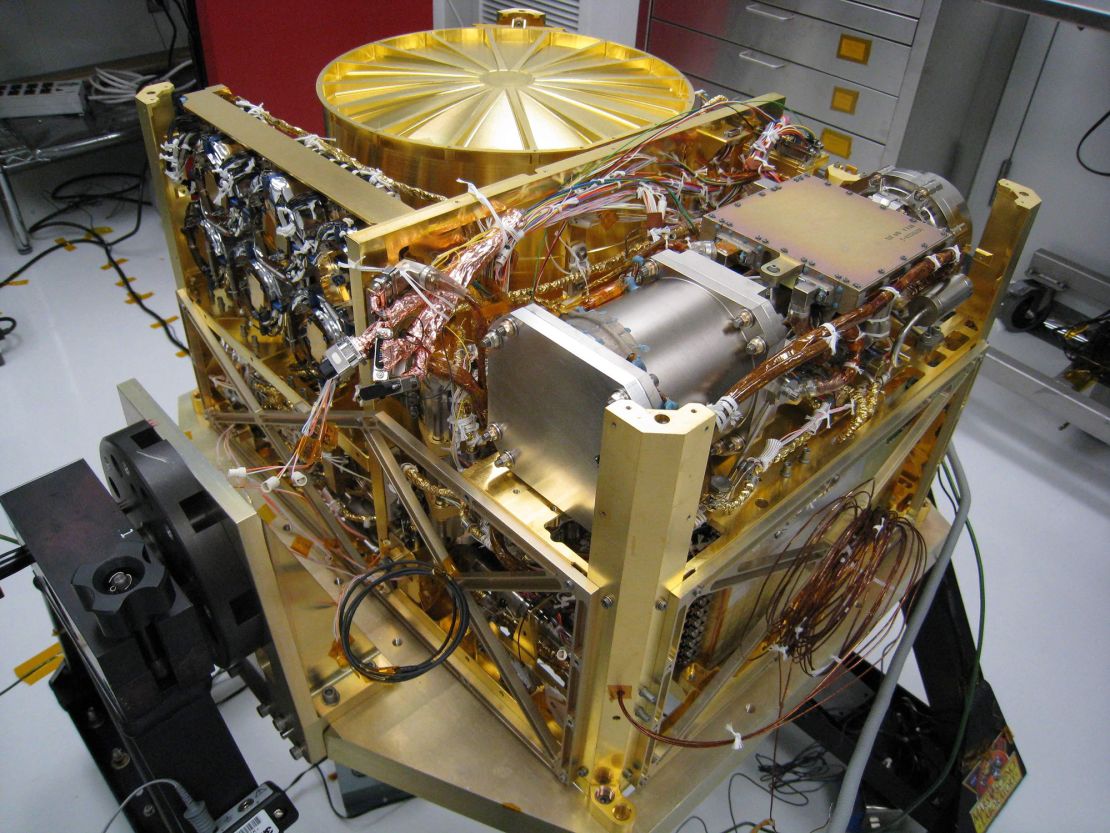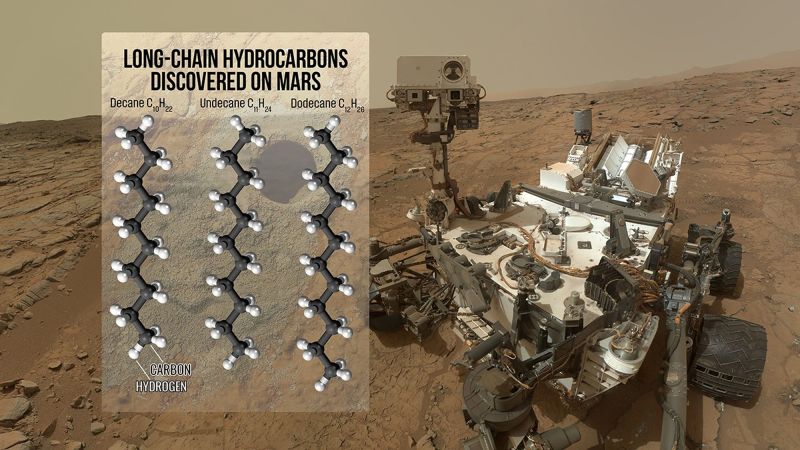Sign up for CNN’s Wonder Theory science newsletter. Explore the universe with news on fascinating discoveries, scientific advancements and more.
CNN
—
The NASA Curiosity rover has detected the largest organic molecules found to date on Mars, opening a window into the red planet’s past. The newly detected compounds suggest complex organic chemistry may have occurred in the planet’s past — the kind necessary for the origin of life, according to new research.
The organic compounds, which include decane, undecane and dodecane, came to light after the rover analyzed a pulverized 3.7 billion-year-old rock sample using its onboard mini lab called SAM, short for Sample Analysis at Mars.
Scientists believe the long chains of molecules could be fragments of fatty acids, which are organic molecules that are chemical building blocks of life on Earth and help form cell membranes. But such compounds can also be formed without the presence of life, created when water interacts with minerals in hydrothermal vents.
The molecules cannot currently be confirmed as evidence of past life on the red planet, but they add to the growing list of compounds that robotic explorers have discovered on Mars in recent years. A study detailing the findings was published Monday in the journal Proceedings of the National Academy of Sciences.
The detection of the fragile molecules also encourages astrobiologists that if any biosignatures, or past signs of life, ever existed on Mars, they are likely still detectable despite the harsh solar radiation that has bombarded the planet for tens of millions of years.
“Ancient life, if it happened on Mars, it would have released some complex and fragile molecules,” said lead study author Dr. Caroline Freissinet, research scientist at the French National Centre for Scientific Research in the Laboratory for Atmospheres, Observations, and Space in Guyancourt, France. “And because now we know that Mars can preserve these complex and fragile molecules, it means that we could detect ancient life on Mars.”
The finding also adds fuel to the fire to return samples from Mars so scientists can study them on Earth with more sophisticated tools, and perhaps, once and for all, determine whether life ever existed anywhere beyond our planet.

Curiosity landed in Gale Crater on August 6, 2012. More than 12 years later, the rover has driven over 21 miles (34 kilometers) to ascend Mount Sharp, which is within the crater. The feature’s many layers preserve millions of years of geological history on Mars, showing how it shifted from a wet to a dry environment.
Perhaps one of the most valuable samples Curiosity has gathered on its mission to understand whether Mars was ever habitable was collected in May 2013.
The rover drilled the Cumberland sample from an area within a crater called Yellowknife Bay, which resembled an ancient lake bed. The rocks from Yellowknife Bay so intrigued Curiosity’s science team that it had the rover drive in the opposite direction to collect samples from the area before heading to Mount Sharp.

Since collecting the Cumberland sample, Curiosity has used SAM to study it in a variety of ways, revealing that Yellowknife Bay was once the site of an ancient lake where clay minerals formed in water. The mudstone created an environment that could concentrate and preserve organic molecules and trapped them inside the fine grains of the sedimentary rock.
Freissinet helped lead a research team in 2015 that was able to identify organic molecules within the Cumberland sample.
The instrument detected an abundance of sulfur, which can be used to preserve organic molecules; nitrates, which are essential for plant and animal health on Earth; and methane composed of a type of carbon associated with biological processes on Earth.
“There is evidence that liquid water existed in Gale Crater for millions of years and probably much longer, which means there was enough time for life-forming chemistry to happen in these crater-lake environments on Mars,” said study coauthor Daniel Glavin, senior scientist for sample return at NASA’s Goddard Space Flight Center in Greenbelt, Maryland, in a statement.

Curiosity has maintained pristine pieces of the Cumberland sample in a “doggy bag” so that the team could have the rover revisit it later, even miles away from the site where it was collected. The team developed and tested innovative methods in its lab on Earth before sending messages to the rover to try experiments on the sample.
In a quest to see whether amino acids, the building blocks of proteins, existed in the sample, the team instructed the rover to heat up the sample twice within SAM’s oven. When it measured the mass of the molecules released during heating, there weren’t any amino acids, but they found something entirely unexpected.
The team was surprised to detect small amounts of decane, undecane and dodecane, so it had to conduct a reverse experiment on Earth to determine whether these organic compounds were the remnants of the fatty acids undecanoic acid, dodecanoic acid and tridecanoic acid, respectively.
The scientists mixed undecanoic acid into a clay similar to what exists on Mars and heated it up in a way that mimicked conditions within SAM’s oven. The undecanoic acid released decane, just like what Curiosity detected.
Each fatty acid remnant detected by Curiosity was made with a long chain of 11 to 13 carbon atoms. Previous molecules detected on Mars were smaller, meaning their atomic weight was less than the molecules found in the new study, and simpler.
“It’s notable that non-biological processes typically make shorter fatty acids, with less than 12 carbons,” said study coauthor Dr. Amy Williams, associate professor of geology at the University of Florida and assistant director of the Astraeus Space Institute, in an email. “Larger and more complex molecules are likely what are required for an origin of life, if it ever occurred on Mars.”
While the Cumberland sample may contain longer chains of fatty acids, SAM is not designed to detect them. But SAM’s ability to spot these larger molecules suggests it could detect similar chemical signatures of past life on Mars if they’re present, Williams said.
“Curiosity is not a life detection mission,” Freissinet said. “Curiosity is a habitability detection mission to know if all the conditions were right … for life to evolve. Having these results, it’s really at the edge of the capabilities of Curiosity, and it’s even maybe better than what we had expected from this mission.”
Before sending missions to Mars, scientists didn’t think organic molecules would be found on the red planet because of the intensity of radiation Mars has long endured, Glavin said.
Curiosity won’t return to Yellowknife Bay during its mission, but there are still pristine pieces of the Cumberland sample aboard. Next, the team wants to design a new experiment to see what it can detect. If the team can identify similar long-chain molecules, it would mark another step forward that might help researchers determine their origins, Freissinet said.
“That’s the most precious sample we have on board … waiting for us to run the perfect experiment on it,” she said. “It holds secrets, and we need to decipher the secrets.”
Briony Horgan, coinvestigator on the Perseverance rover mission and professor of planetary science at Purdue University in West Lafayette, Indiana, called the detection “a big win for the whole team.” Horgan was not involved the study.

“This detection really confirms our hopes that sediments laid down in ancient watery environments on Mars could preserve a treasure trove of organic molecules that can tell us about everything from prebiotic processes and pathways for the origin of life, to potential biosignatures from ancient organisms,” Horgan said.
Dr. Ben K.D. Pearce, assistant professor in Purdue’s department of Earth, atmospheric, and planetary sciences and leader of the Laboratory for Origins and Astrobiology Research, called the findings “arguably the most exciting organic detection to date on Mars.” Pearce did not participate in the research.
Some scientists believe that fatty acids such as decanoic acid and dodecanoic acid formed the membranes of the first simple cell-like structures on Earth, Pearce said.
“(This is) the closest we’ve come to detecting a major biomolecule-related signal — something potentially tied to membrane structure, which is a key feature of life,” Pearce said via email. “Organics on their own are intriguing, but not evidence of life. In contrast, biomolecules like membranes, amino acids, nucleotides, and sugars are central components of biology as we know it, and finding any of them would be groundbreaking (we haven’t yet).”
The European Space Agency plans to launch its ExoMars Rosalind Franklin rover to the red planet in 2028, and the robotic explorer will carry a complementary instrument to SAM. The rover LS6 will have the capability to drill up to 6.5 feet (2 meters) beneath the Martian surface — and perhaps find larger and better-preserved organic molecules.
While Curiosity’s samples can’t be studied on Earth, the Perseverance rover has actively been collecting samples from Jezero Crater, the site of an ancient lake and river delta, all with the intention of returning them to Earth in the 2030s via a complicated symphony of missions called Mars Sample Return.
Both rovers have detected a variety of organic carbon molecules in different regions on Mars, suggesting that organic carbon is common on the red planet, Williams said.
While Curiosity and Perseverance have proven they can detect organic matter, their instruments can’t definitively determine all the answers about their origins, said Dr. Ashley Murphy, postdoctoral research scientist at the Planetary Science Institute. Murphy, who along with Williams previously studied organics identified by Perseverance, was not involved in the new research.
“To appropriately probe the biosignature question, these samples require high-resolution and high-sensitivity analyses in terrestrial labs, which can be facilitated by the return of these samples to Earth,” Murphy said.
If the molecules within the Cumberland sample are the byproduct of microbial life that existed 3.7 billion years ago, such a finding would align with the same time frame as when scientists think life was starting on Earth, Glavin said. Curiosity’s finding feels “so close” to helping make that determination, but the answers are more likely to come from studying samples on Earth, he said.
“I’m more optimistic that we’re going to finally be able to settle this life on Mars debate, which feels like it’s been going on forever,” Glavin said.

